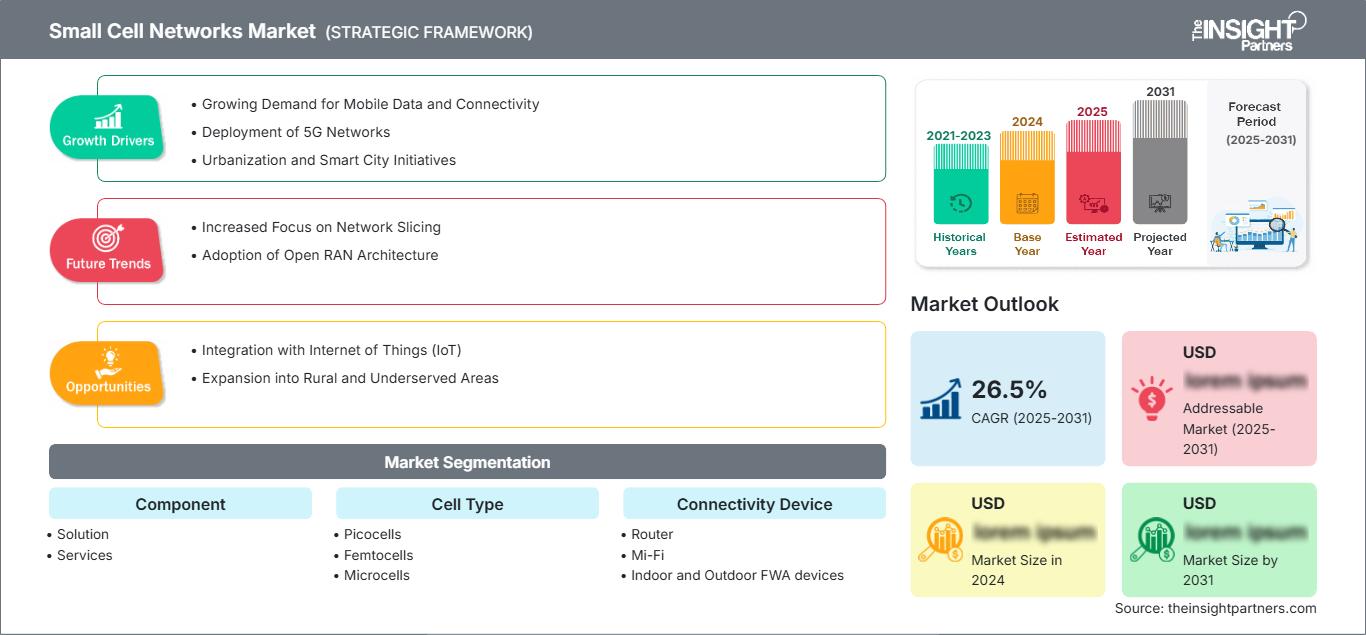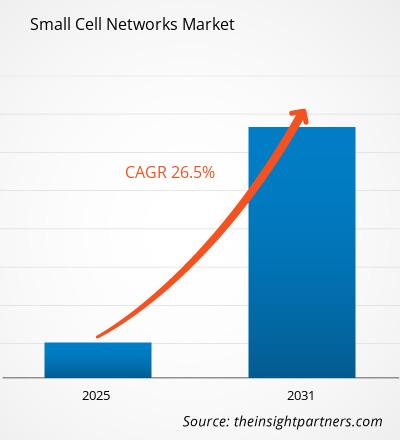Si prevede che il mercato delle reti a piccole celle registrerà un CAGR del 26,5% dal 2025 al 2031, con una dimensione del mercato in espansione da XX milioni di dollari nel 2024 a XX milioni di dollari entro il 2031.
Il rapporto è segmentato per componente [soluzione, servizi (consulenza, distribuzione e integrazione, formazione, supporto e manutenzione)]; tipo di cella (picocelle, femtocelle, microcelle, metrocelle); dispositivo di connettività (router, Mi-Fi, dispositivi FWA per interni ed esterni, gateway, altri); distribuzione (esterna, interna); utenti finali (residenziale, commerciale, industriale). L'analisi globale è ulteriormente suddivisa a livello regionale e per i principali paesi. Il rapporto offre il valore in USD per l'analisi e i segmenti sopra indicati.
Scopo del rapporto
Il rapporto Small Cell Networks Market di The Insight Partners mira a descrivere il panorama attuale e la crescita futura, i principali fattori trainanti, le sfide e le opportunità. Ciò fornirà spunti a vari stakeholder aziendali, come:
- Fornitori/Produttori di tecnologia: per comprendere le dinamiche di mercato in evoluzione e conoscere le potenziali opportunità di crescita, consentendo loro di prendere decisioni strategiche informate.
- Investitori: per condurre un'analisi completa delle tendenze in merito al tasso di crescita del mercato, alle proiezioni finanziarie di mercato e alle opportunità esistenti lungo la catena del valore.
- Enti di regolamentazione: per regolamentare le politiche e le attività di controllo sul mercato con l'obiettivo di ridurre al minimo gli abusi, preservare la fiducia degli investitori e sostenere l'integrità e la stabilità del mercato.
Componente di segmentazione del mercato delle reti di piccole celle
- Soluzione
- Servizi
Tipo di cella
- Picocelle
- Femtocelle
- Microcelle
- MetroCell
Dispositivo di connettività
- Router
- Mi-Fi
- Dispositivi FWA per interni ed esterni
- Gateway
Distribuzione
- Esterni
- Interni
Utenti finali
- Residenziale
- Commerciale
- Industriale
Potrai personalizzare gratuitamente qualsiasi rapporto, comprese parti di questo rapporto, o analisi a livello di paese, pacchetto dati Excel, oltre a usufruire di grandi offerte e sconti per start-up e università
Mercato delle reti di piccole celle: Approfondimenti strategici

-
Ottieni le principali tendenze chiave del mercato di questo rapporto.Questo campione GRATUITO includerà l'analisi dei dati, che vanno dalle tendenze di mercato alle stime e alle previsioni.
Fattori di crescita del mercato delle reti a piccole celle
- Crescente domanda di dati e connettività mobili: la crescente dipendenza dai dispositivi mobili e il conseguente aumento del traffico dati mobile sono i principali fattori trainanti per il mercato delle reti a piccole celle. Poiché consumatori e aziende richiedono una connettività più veloce e affidabile, le reti macrocellulari tradizionali faticano a soddisfare queste esigenze, in particolare nelle aree urbane densamente popolate. Le piccole celle, che migliorano la capacità e la copertura della rete, sono essenziali per fornire servizi dati ad alta velocità, rendendole una soluzione interessante per gli operatori di telefonia mobile che mirano a migliorare l'esperienza e la soddisfazione degli utenti.
- Implementazione delle reti 5G: l'implementazione in corso della tecnologia 5G è un fattore trainante significativo per il mercato delle reti a piccole celle. Le piccole celle sono parte integrante dell'infrastruttura 5G, fornendo la densificazione necessaria per supportare bande ad alta frequenza e velocità di trasmissione dati migliorate. Poiché le aziende di telecomunicazioni investono massicciamente nell'implementazione del 5G per soddisfare le aspettative dei consumatori di una connettività più veloce, la domanda di soluzioni a piccole celle continuerà a crescere. Si prevede che questa tendenza accelererà l'adozione delle piccole celle come componente chiave delle reti wireless di prossima generazione.
- Urbanizzazione e iniziative per le città intelligenti: l'urbanizzazione sta portando a un aumento della densità di popolazione nelle città, creando un'urgente necessità di una connettività wireless migliorata. Le reti a piccole celle svolgono un ruolo cruciale nelle iniziative per le città intelligenti, fornendo l'infrastruttura necessaria per i dispositivi Internet of Things (IoT), la gestione intelligente del traffico e servizi di sicurezza pubblica migliorati. Con l'impegno delle città a diventare più intelligenti e connesse, si prevede un aumento dell'adozione delle reti a piccole celle, stimolando la crescita del mercato e offrendo opportunità di innovazione nelle telecomunicazioni urbane.
Trend futuri del mercato delle reti a piccole celle
- Maggiore attenzione al network slicing: una tendenza importante nel mercato delle reti a piccole celle è la crescente attenzione al network slicing, in particolare nel contesto della tecnologia 5G. Il network slicing consente agli operatori di creare più reti virtuali su un'unica infrastruttura fisica, ciascuna personalizzata per specifici casi d'uso e accordi sul livello di servizio. Questa capacità migliora l'efficienza e la flessibilità delle implementazioni di piccole celle, consentendo agli operatori di gestire meglio le risorse e fornire servizi personalizzati a diversi segmenti di utenti, come aziende, consumatori e applicazioni IoT.
- Adozione dell'architettura Open RAN: il passaggio all'architettura Open RAN (Radio Access Network) è una tendenza significativa che sta influenzando il mercato delle reti di piccole celle. L'Open RAN promuove l'interoperabilità e la diversità dei fornitori consentendo agli operatori di combinare componenti di diversi fornitori. Questa tendenza incoraggia l'innovazione e riduce i costi, consentendo agli operatori più piccoli di entrare nel mercato. Con l'adozione dei principi Open RAN da parte delle aziende di telecomunicazioni, l'implementazione di piccole celle diventerà più flessibile ed economica, promuovendo un panorama competitivo e accelerando la crescita del mercato.
Opportunità di mercato per le reti di piccole celle
- Integrazione con l'Internet of Things (IoT): la proliferazione di dispositivi IoT offre opportunità significative per il mercato delle reti di piccole celle. Le piccole celle possono supportare le esigenze di connettività di varie applicazioni IoT, come contatori intelligenti, monitoraggio ambientale e trasporti intelligenti. Con l'adozione sempre più diffusa di soluzioni IoT da parte di industrie e amministrazioni comunali per ottimizzare le operazioni e migliorare i servizi, la domanda di reti small cell affidabili e ad alta capacità crescerà. Ciò crea un'opportunità redditizia per i provider di sviluppare soluzioni small cell personalizzate che soddisfino le esigenze specifiche delle applicazioni IoT.
- Espansione in aree rurali e svantaggiate: esiste una notevole opportunità per le reti small cell di espandersi in aree rurali e svantaggiate, dove le reti macrocell tradizionali potrebbero essere insufficienti. Implementando small cell in queste regioni, i provider di servizi possono migliorare la copertura e la connettività per residenti e aziende. Questa espansione non solo affronta il divario digitale, ma apre anche nuovi mercati per le aziende di telecomunicazioni, che possono attingere a popolazioni precedentemente svantaggiate alla ricerca di una connettività mobile affidabile.
Approfondimenti regionali sul mercato delle reti di piccole celle
Le tendenze regionali e i fattori che influenzano il mercato delle reti a piccole celle durante il periodo di previsione sono stati ampiamente spiegati dagli analisti di The Insight Partners. Questa sezione illustra anche i segmenti e la geografia del mercato delle reti a piccole celle in Nord America, Europa, Asia-Pacifico, Medio Oriente e Africa, America Meridionale e Centrale.
Ambito del rapporto di mercato sulle reti di piccole celle
| Attributo del rapporto | Dettagli |
|---|---|
| Dimensioni del mercato in 2024 | US$ XX million |
| Dimensioni del mercato per 2031 | US$ XX Million |
| CAGR globale (2025 - 2031) | 26.5% |
| Dati storici | 2021-2023 |
| Periodo di previsione | 2025-2031 |
| Segmenti coperti |
By Componente
|
| Regioni e paesi coperti |
Nord America
|
| Leader di mercato e profili aziendali chiave |
|
Densità degli operatori del mercato delle reti di piccole celle: comprendere il suo impatto sulle dinamiche aziendali
Il mercato delle reti Small Cell è in rapida crescita, trainato dalla crescente domanda degli utenti finali, dovuta a fattori quali l'evoluzione delle preferenze dei consumatori, i progressi tecnologici e una maggiore consapevolezza dei vantaggi del prodotto. Con l'aumento della domanda, le aziende stanno ampliando la propria offerta, innovando per soddisfare le esigenze dei consumatori e sfruttando le tendenze emergenti, alimentando ulteriormente la crescita del mercato.

- Ottieni il Mercato delle reti di piccole celle Panoramica dei principali attori chiave
Punti di forza
- Copertura completa: il rapporto analizza in modo esaustivo prodotti, servizi, tipologie e utenti finali del mercato delle reti a piccole celle, offrendo una panoramica olistica.
- Analisi degli esperti: il rapporto è redatto sulla base della conoscenza approfondita di esperti e analisti del settore.
- Informazioni aggiornate: il rapporto garantisce la pertinenza aziendale grazie alla copertura di informazioni e tendenze dei dati recenti.
- Opzioni di personalizzazione: questo rapporto può essere personalizzato per soddisfare le esigenze specifiche del cliente e adattarsi in modo appropriato alle strategie aziendali.
Il rapporto di ricerca sul mercato delle reti a piccole celle può quindi contribuire a guidare il percorso di decodificazione e comprensione dello scenario del settore e delle prospettive di crescita. Sebbene possano esserci alcune valide preoccupazioni, i vantaggi complessivi di questo rapporto tendono a superare gli svantaggi.
- Analisi storica (2 anni), anno base, previsione (7 anni) con CAGR
- Analisi PEST e SWOT
- Valore/volume delle dimensioni del mercato - Globale, Regionale, Nazionale
- Industria e panorama competitivo
- Set di dati Excel
Report recenti
Rapporti correlati
Testimonianze
Motivo dell'acquisto
- Processo decisionale informato
- Comprensione delle dinamiche di mercato
- Analisi competitiva
- Analisi dei clienti
- Previsioni di mercato
- Mitigazione del rischio
- Pianificazione strategica
- Giustificazione degli investimenti
- Identificazione dei mercati emergenti
- Miglioramento delle strategie di marketing
- Aumento dell'efficienza operativa
- Allineamento alle tendenze normative






















 Ottieni un campione gratuito per - Mercato delle reti di piccole celle
Ottieni un campione gratuito per - Mercato delle reti di piccole celle